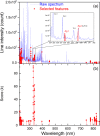Machine Learning Allows Calibration Models to Predict Trace Element Concentration in Soils with Generalized LIBS Spectra
- PMID: 31388047
- PMCID: PMC6684658
- DOI: 10.1038/s41598-019-47751-y
Machine Learning Allows Calibration Models to Predict Trace Element Concentration in Soils with Generalized LIBS Spectra
Abstract
Determination of trace elements in soils with laser-induced breakdown spectroscopy is significantly affected by the matrix effect, due to large variations in chemical composition and physical property of different soils. Spectroscopic data treatment with univariate models often leads to poor analytical performances. We have developed in this work a multivariate model using machine learning algorithms based on a back-propagation neural network (BPNN). Beyond the classical chemometry approach, machine learning, with tremendous progresses the last years especially for image processing, is offering an ensemble of powerful and constantly renewed algorithms and tools efficient for the different steps in the construction of a spectroscopic data treatment model, including feature selection and neural network training. Considering the matrix effect as the focus of this work, we have developed the concept of generalized spectrum, where the information about the soil matrix is explicitly included in the input vector of the model as an additional dimension. After a brief presentation of the experimental procedure and the results of regression with a univariate model, the development of the multivariate model will be described in detail together with its analytical performances, showing average relative errors of calibration (REC) and of prediction (REP) within the range of 5-6%.
Conflict of interest statement
The authors declare no competing interests.
Figures










Similar articles
-
Evaluation of laser induced breakdown spectroscopy for multielemental determination in soils under sewage sludge application.Talanta. 2011 Jul 15;85(1):435-40. doi: 10.1016/j.talanta.2011.04.001. Epub 2011 Apr 8. Talanta. 2011. PMID: 21645722
-
Matrix Effects in Quantitative Analysis of Laser-Induced Breakdown Spectroscopy (LIBS) of Rock Powders Doped with Cr, Mn, Ni, Zn, and Co.Appl Spectrosc. 2017 Apr;71(4):600-626. doi: 10.1177/0003702816685095. Epub 2017 Jan 1. Appl Spectrosc. 2017. PMID: 28374610
-
Correlation-based carbon determination in steel without explicitly involving carbon-related emission lines in a LIBS spectrum.Opt Express. 2020 Oct 12;28(21):32019-32032. doi: 10.1364/OE.404722. Opt Express. 2020. PMID: 33115165
-
A novel hybrid feature selection strategy in quantitative analysis of laser-induced breakdown spectroscopy.Anal Chim Acta. 2019 Nov 8;1080:35-42. doi: 10.1016/j.aca.2019.07.012. Epub 2019 Jul 9. Anal Chim Acta. 2019. PMID: 31409473
-
Machine learning efficiently corrects LIBS spectrum variation due to change of laser fluence.Opt Express. 2020 May 11;28(10):14345-14356. doi: 10.1364/OE.392176. Opt Express. 2020. PMID: 32403475
Cited by
-
Impact of conformation and intramolecular interactions on vibrational circular dichroism spectra identified with machine learning.Commun Chem. 2023 Jul 12;6(1):148. doi: 10.1038/s42004-023-00944-z. Commun Chem. 2023. PMID: 37438485 Free PMC article.
-
Metal contamination - a global environmental issue: sources, implications & advances in mitigation.RSC Adv. 2025 Feb 11;15(5):3904-3927. doi: 10.1039/d4ra04639k. eCollection 2025 Jan 29. RSC Adv. 2025. PMID: 39936144 Free PMC article. Review.
-
Machine learning-based LIBS spectrum analysis of human blood plasma allows ovarian cancer diagnosis.Biomed Opt Express. 2021 Apr 2;12(5):2559-2574. doi: 10.1364/BOE.421961. eCollection 2021 May 1. Biomed Opt Express. 2021. PMID: 34123488 Free PMC article.
-
Machine Learning Spectroscopy Using a 2-Stage, Generalized Constituent Contribution Protocol.Research (Wash D C). 2023 Apr 20;6:0115. doi: 10.34133/research.0115. eCollection 2023. Research (Wash D C). 2023. PMID: 37287889 Free PMC article.
-
Quantitative Analysis of Pb in Soil Using Laser-Induced Breakdown Spectroscopy Based on Signal Enhancement of Conductive Materials.Molecules. 2024 Aug 5;29(15):3699. doi: 10.3390/molecules29153699. Molecules. 2024. PMID: 39125103 Free PMC article.
References
-
- Mallarino, A. P. Testing of soils. in Encyclopedia of soils in the environment, 143–143 (Elsevier, 2005).
-
- McGrath, S. P. Pollution/Industrial. in Encyclopedia of soils in the environment, 282–287 (Elsevier, 2005).
-
- Kirkby, E. A. Essential elements. in Encyclopedia of soils in the environment, 478–485 (Elsevier, 2005).
-
- Singh V, Agrawal HM. Qualitative soil mineral analysis by EDXRF, XRD and AAS probes. Radiat. Phys. Chem. 2012;81:1796–1803. doi: 10.1016/j.radphyschem.2012.07.002. - DOI
Grants and funding
- 11805126/National Natural Science Foundation of China (National Science Foundation of China)
- 11601327/National Natural Science Foundation of China (National Science Foundation of China)
- 11574209/National Natural Science Foundation of China (National Science Foundation of China)
- 15142201000/Science and Technology Commission of Shanghai Municipality (Shanghai Municipal Science and Technology Commission)
LinkOut - more resources
Full Text Sources
Other Literature Sources

